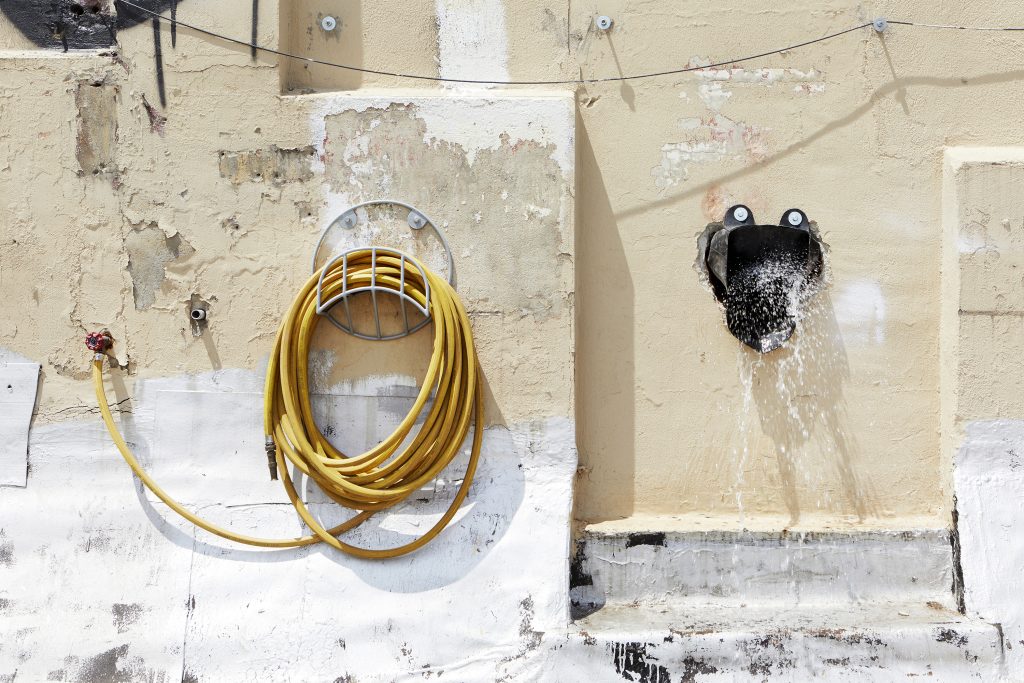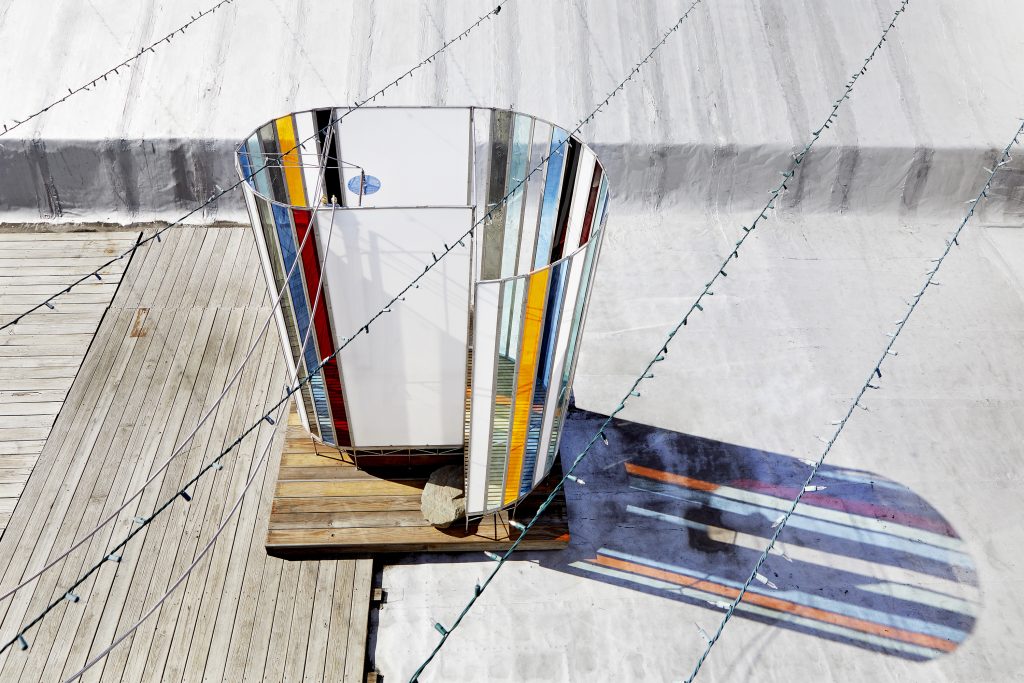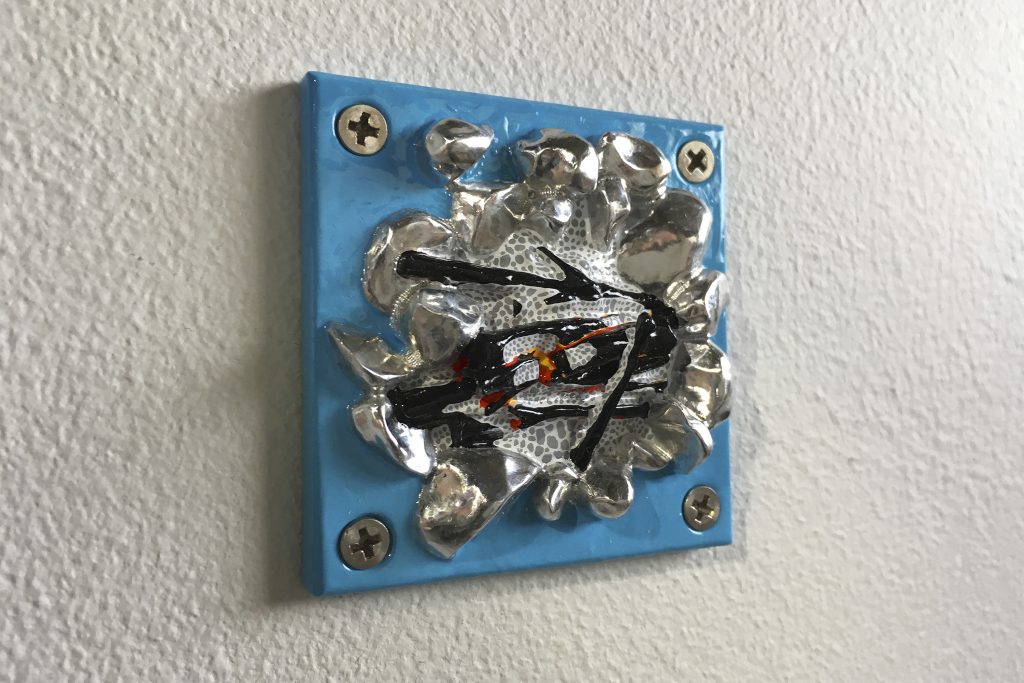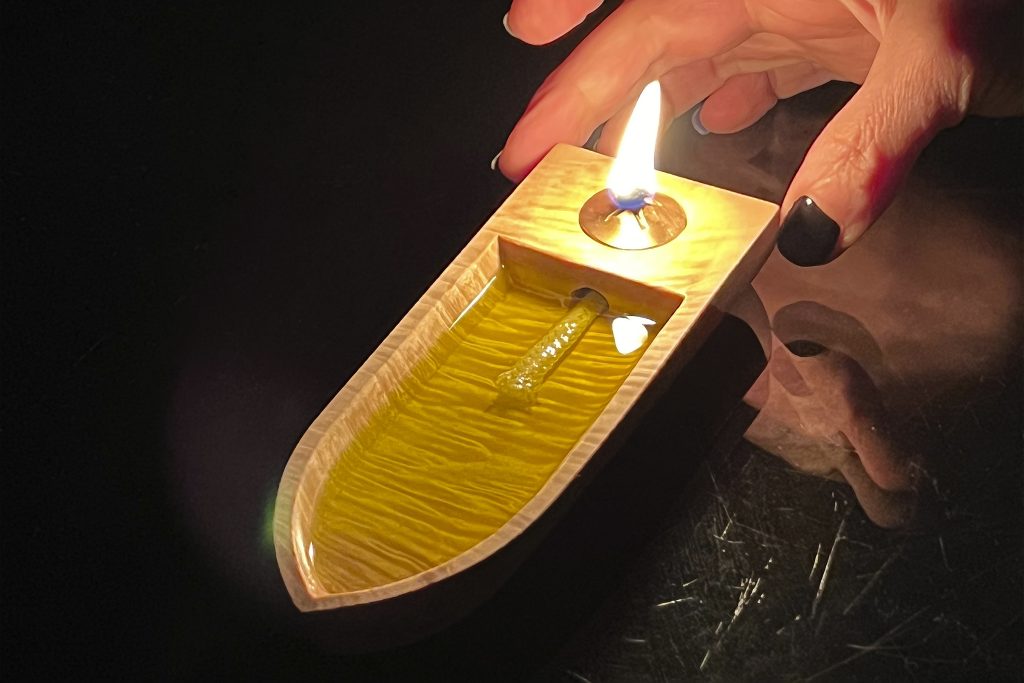Mark Golden: Gordon, thank you so much for allowing me to explore your story and share it with our artist community. As our newest Materials and Applications Specialist, I’m sure they will get to know you and certainly appreciate your expertise, so thank you for this opportunity.
Gordon Millsaps: Thanks for showing interest.
Mark: You bet. Gordon, what’s your earliest memory of creating art, or particularly, any influences at home?
Gordon: There are many. There are all sorts of material interaction memories, you know, playing with a can of shaving cream or damming a creek. But in terms of actual art study, the earliest memory might be when my mother came to guest-teach an art class when I was in kindergarten. She was walking around the room and we were drawing with pencils and crayons. I’m drawing a landscape. I’ve got the sun in the top corner. I’ve got the band of blue along the top, like a proper five-year-old’s drawing. I asked her a question then that I wouldn’t have asked at home, as I’m up at the top filling in the blue, I ask, “Where does the sky end?” and she says, “It doesn’t. It goes all the way to the ground.” That’s one of the of the earliest concrete art study memories I have. I guess that created an association with moments of mind expansion.
Mark: When was the time that you actually explored art seriously? Was it in grade school or high school, or much later?
Gordon: Oh, it was always a foregone conclusion that I was going to study art. That was personal – my parents never pushed it on me at all. Actually, the only job my mom suggested I explore was being a lawyer. But both parents only truly looked up to artists. Nothing else made sense to me, nothing approached the world with intuition like an art practice, which is essentially an exploration of freedom.
Mark: So, the art practice wasn’t just in material. Was it also in music or literature or another space?
Gordon: Yeah, it was all over. I tried out pretty much anything I thought might allow me to get that feeling of heading for the horizon, to something I hadn’t seen before. I took composition classes, always studied science and technology, and started playing instruments when I was ten. Music and visual arts really stuck. It was something about the kinetic aspect of moving and having vibrations or materials kind of bounce back in my face.
Mark: What was your instrument or instruments?
Gordon: Well, come to think of it, I started singing when I was eight, so voice is the foundation. We couldn’t afford instrument rental, so I went for the cheapest instrument: voice. I started out singing in choirs and, you know, learning German lieder music and stuff like that. Guitar and other instruments came in later, after a lot of yard sale hunting.
Mark: Did that interest in music continue through high school and college? When did you consider fine art making as a career?
Gordon: Music and visual art were always a somewhat painful bifurcation of my brain. I’ve never been able to square the circle with them, so I’ve bounced back and forth. My first real paying work was recording people with a little mobile recording studio in high school. I thought when I moved to New York City that I would be recording people as I did throughout college. It turned out that fabricating sculpture was far more consistent and lucrative.
Mark: What were you studying in college?
Gordon: I got a Bachelor of Arts from Vassar College, so it was general studies and the liberal arts disciplines, but my focus was in Studio Art. Every free hour outside of that, I was recording music in my dorm room and churches and performance halls, mostly jazz and classical students. I was splitting my time and it made me feel like I was being torn in pieces.
Mark: One of the things that I wanted to ask about was your style, which has such a unique approach and it’s a pretty broad reach. How did that evolve over time? Did it take time to find that voice, or is it still a discovery process for you?
Gordon: Oh, I definitely don’t recognize my own voice. I think clawing around for it is my process. If I ever feel like I’ve arrived or I’ve figured out my system, I’ll have to quit. I don’t know another method than a searching one. I think that’s what leads me, in my own work, to use a lot of different materials, because it’s the rub between them, it’s the things I haven’t seen before that are so fascinating, that makes them feel substantial. Maybe somewhat pejoratively, my wife says that I’m allergic to doing anything I’ve seen before, but it sounds right. I’ve had the experience of going way down the path of some project, and then someone’s like, “Oh, that’s exactly like this! Have you seen this before?” And suddenly, the blood drains out of the idea.
Mark: That’s been an interest of mine to explore with you. You do use unique materials and fabrication processes in your work. Tell me about that. What are some of the unique or unusual materials that you’ve ever worked with, and how did they influence the creative process?

Gordon: Well, I didn’t know anything about my interest in sculpture before college, because I didn’t really have access to a shop or tools. My father was a carpenter and a woodworker, but he was long gone and the tools were sold years before I got interested. All that was left for making my skateboard ramps was yard sale drills, rusty chisels, and a circular saw with no safeties and a frayed cable. So, I thought tools were something that were hard to use. I thought they were supposed to be painful and unpleasant. And then suddenly, I had access to a nice workshop in college, I couldn’t believe it. I was better my first day on the table saw than I was after ten years of playing guitar. I realized, “Oh, there’s some natural resonance happening here.” It seemed easy. It never crossed my mind to focus on a single material. Whenever I was working with a few materials at once, they’d have things to say to each other and they’d offer possibilities I hadn’t imagined before. The synthesis was between two odds meeting, and after a while, I realized that within combinations, I could see infinity, essentially. I could see all the potential for world-building that any art practice might ask for. Combining some summer break carpentry work with sculpture classes and my interest in instruments gave me all the introductory exposure to tools and materials that art fabrication requires. Somehow a fixation on plumbing and electrical systems got tacked on. After college, it turned out those skills were exactly what was required to work in almost any artist’s studio. And then, once I had someone else’s money to spend, my interests expanded into stainless steel and acrylic and mold-making, and just about anything you could think of, including most types of coatings.
Mark: Gordon, one of the things that is really unique about your expertise is how much material knowledge you’ve gained and the broad range of expertise that you bring, and I was wondering where you gained that. Was it in college or on the job? Or was it just your sense of curiosity and wanting to delve deeper into this?
Gordon: I was in a very – I don’t want to say it was theory-heavy – but a very conceptual program in college, which I’m grateful for. But I experienced a good deal of pushback when I tried to get technical with materials. They would say, “This is not a vocational school.” They wanted us to stay light materially and heavy conceptually, so it was sort of against that flow that I pursued a deeper exploration of different material approaches for completing my work. And the result was me not finishing a single project within the parameters of the semester system. I would keep working on a single piece through summer and vacations. Some college work ended up taking years to complete, at which point it was completely irrelevant for class purposes. The curiosity really took hold of me and I wouldn’t fight that impulse, even though it didn’t suit the requirements of the structure I was in.

Mark: Is a lot of what you try to do very controlled? Or do you allow that kind of sense of serendipity to filter into the work?
Gordon: In the early days I was a lot more controlled. Now, I hope I never have a consistent answer to that question. I believe that sometimes you have to approach a project from the top down, where you know what it needs to be, and you just need to run around the world and find the pieces to assemble a concept. And you may need to fight pretty hard against your circumstances to see it through, and that kind of bullheadedness can actually serve you well. But then there are times where something can emerge from the bottom-up, where you collect things, not knowing why you’re collecting them, but they just flicker with potential. And you might even need to let them sit in the corner for a year or two until suddenly, maybe through some tests, maybe just through daily meditation, you realize what they could become. Maybe you have to assemble them, and they fall down, and you assemble them again, and that time it works. So yeah, I bounce back and forth now, and I just want to increase the swing between the two. I’m glad to be out of an assignment-based world where I needed to get a grade or hit a deadline with tight parameters – it was way less exploratory and open-ended.
Mark: And that probably existed also while you were working for other clients and producing artwork, right?
Gordon: That was the toughest, because in the professional art world, which can run on a tight calendar and budget, you usually need to make something exactly right the first time. The prototype is the finished work, and I had to be able to look someone in the eyes and say, “Yes, we will get it done in two months,” even though it’s an object I’ve never seen before. Ideally, an object that no one has seen before.
Mark: Are there any conversations that you thought you would have liked to have with either an historical artist or an artist that is alive now, and what might that be? What would you have asked them?
Gordon: Oh, gosh. I mean, hundreds of those conversations. But, I’m usually trying to quiet the voices in my head as I’m trying to focus, because I’m sort of overrun with voices of those who inspired me or those who hired me. After a few decades, they really add up.
I probably think most often of temple stone masons or cave-painters. But I don’t want to ask them anything, just watch them work. I guess I’d like to talk to Marcel Duchamp. I’ve been thinking a lot about cynicism because it’s so pervasive, and how people use it as a shortcut to understanding the world. It’s too easy to be dismissive. I’d like to ask Duchamp what led him to semi-retire from being an artist to play chess, because for me, it’s a pretty cynical response to not knowing what to do next. I want to explore why he couldn’t invent a game for himself that he couldn’t win.
Mark: Yeah, I thought the urinal was originally a cynical response.
Gordon: Um, it’s a smirking response, you know, and there’s a lot there. I think material humor is an entire language, and I have a lot of heroes there, like Fluxus, Duchamp is another. But again, for me, one of my personal goals is to have an endless road in front of me, so for someone to find the end of their road is a little heartbreaking.
Mark: You described, just briefly, meditating. Is that part of your practice?
Gordon: Not a formalized system of meditation. I’ve explored a few meditation styles, but the thousands of hours I’ve spent on rhythm has developed into a more durable approach. If rhythm didn’t morph into meditation through practice, I wouldn’t have been able to spend thousands of hours doing it. So that meditative place for me typically involves a meditation tool, which is a musical instrument. I could easily spend months without speaking if I had a couple of instruments.
Mark: That’s great. Is there one piece of art, maybe yours, or someone else’s, that changed the way that you see the world?
Gordon: Just pick one? I don’t know, picking one might be a little disingenuous.
Mark: It’s always difficult. “What’s your favorite?” It’s like, well, I have many favorites.
Gordon: Yeah, yeah. And often there might be one that’s carrying you through this season. But then a few years later, you’re like, wow, that album, or whatever, really got me through that year, but it is unlistenable now.
Mark: Well, how about recently? Is there anything, any work of yours or someone else’s, that recently has got you inspired in the studio?
Gordon: One of my friends, Marc Hundley, had a show at Canada Gallery in Manhattan last year that’s been bouncing around my head. It was a show of nearly billboard-sized paintings that made me feel like I was out at night on the seediest Parisian streets. The opening turned into a party, and dancing to Ron Like Hell around that gallery has stuck with me.
Mark: So, you said if you weren’t working in the fine arts, you’d be drawn to doing your music. Writing music or playing, or both?
Gordon: I’ve been writing and playing since I was about ten. It’s never been a professional pursuit, but it’s kind of the other side of the coin for me.
Mark: Solo practice or with others?
Gordon: Both, but when I’m really doing my thing, it’s a pretty insular, personal, meditative sort of thing.
Mark: So, you’ve had a chance over the last few months to be able to play with materials at the factory. I’m not sure what you thought, as you were entering Golden Artist Colors, about what you’d be exploring or what you’re doing. Any surprises as you joined and actually got your feet wet and hands into the muck?
Gordon: I’m surprised to walk the floor each day and see every color go through the process, that it’s all very manual and human. There are people here that are passionate about hunting down issues or carefully inspecting attributes of countless tests. I didn’t expect my work to push me past material methods into microscopy and Fourier Transform Infrared Spectroscopy (FTIR) analysis. I’m surprised that there are four labs here, all working interdependently to serve the paintmakers. That whole system is unexpected. You’d assume it’d be more automated, that more materials would be created off-site, or offshore and imported. To see that it’s a big art studio in its own right makes it a funny bright spot in American manufacturing. You can’t blame people for assuming that production is outsourced or automated, but then it’s an uphill push to explain to folks how different things can be.
Mark: You have to prove it, as opposed to saying it. You have to just keep doing it, which is what we do. So, what brought you to Golden Artist Colors? What brought you up to New Berlin, New York?
Gordon: Well, Ulysses Jackson [GOLDEN Research & Development Director] was one of my earliest artistic influences. He’s the first skateboarding, guitar-playing painter I knew. He was a major pull. I’ve lived nearby for five years now, and I’ve been fabricating art for others since I graduated from college. It was engrossing work and at times even kind of fancy, but it took up a lot of space. Recently, I finally accepted that I was never going to be able to focus on my own practice with other people’s work in my studio. Within a couple months of making that decision, this job materialized. I hope it helps me create an empty studio, a void for myself to fill. I also thought it might be a way to test my high-minded ideals about the corporate world, about material sourcing, about what it means to make art with industrialized materials. So many artists conveniently ignore material origins despite the increasing super-moralization of art discourse. I want to get front-seat exposure to the system I’ve come up in and learn some truths about the materials I’ve been using my whole life.

Mark: What’s really exciting for all of us is the dedication that the artist and material geeks really bring. You bring a passion for an understanding and a curiosity, but also a dedication, not just to yourself, but to all artists, knowing that you’re a stand-in for every other person who is buying a blind product. With your role here, you can give customers assurance about the materials and their application and you can share what you’re responsible for: making sure that you’re standing behind, that we’re standing behind, and that the company’s standing behind what it says it can deliver.
Gordon: Yeah, that won my trust, when I was told from the get-go that I wouldn’t be asked to sell people anything. I’m glad to give people my straightforward take on what materials do, what they’re capable of, and how they compare to other options out there. That’s something I’ve always done, regardless of my employment.
Mark: Right. So, I have to ask, is there one art superstition or quirky habit that you have while working? Any pre-creation rituals that you have?
Gordon: I guess when you spend decades making work, you collect a lot of habits and rituals. There are two that come to mind really quickly. One is holding my breath when mixing anything, because I spent a lot of my early days working with no respirator, just sprinting to the window for a fresh breath every thirty seconds. That’s more practical than ritualistic! On the more superstitious side of things, I have a tendency to just circle a project for a while before lying down in it, sort of like a dog going to bed. I’ll pull everything together and just wait for a feeling of readiness. I’ve got piles of tree trunks cut fifty years ago and chunks of steel off the streets of Brooklyn, and whatnot, that are just waiting. And I’m waiting for them to glow in just the right way. I’d say that’s the strongest pseudo-spiritual process I’ve got, slowly waiting for these inanimate things to animate.
Mark: So, are they surrounding your studio? Are they like little totems to some future state?
Gordon: Absolutely. Su and I call it the “slide puzzle” because you can’t move or access any one thing without moving something else. So, there’s this slide puzzle of various materials, just waiting for a bolt of lightning, good or bad.
Mark: What’s the most surprising thing that someone else has ever said about your work, and how did it make you feel?
Gordon: Surprising… well, it’s honestly pretty simple. I have one friend who literally turned to me at the end of a show and said, “Whatever you do, keep making work.” It was such a sweet and considerate thing to say. For someone to look at you intently and say, “I hope you don’t waver and that you stay on this.” That was the most touching thing to hear.

Mark: Tell me a little bit about the experience of living up here in upstate New York.
Gordon: It’s good for those who have a monkish devotion to their practice. Since the farm I grew up on, it’s the best place I’ve found for focus and connection to nature, which is increasingly rare. I’m also glad for the shift outside of the political bubbles I’ve found myself in previously.
Mark: And you’re still able to find a community of support.
Gordon: Yeah, it means a lot for us to live amongst farms, to see the systems that feed us and learn from the farmers. My local transfer station is my favorite hang and material source. There’s killer programming near us at Luck Dragon and the West Kortright Center. And artists are everywhere, they always are.
Mark: Gordon, I really appreciate the time and the insights and the personal recollections, so thank you.
Gordon: Thanks for your time!
